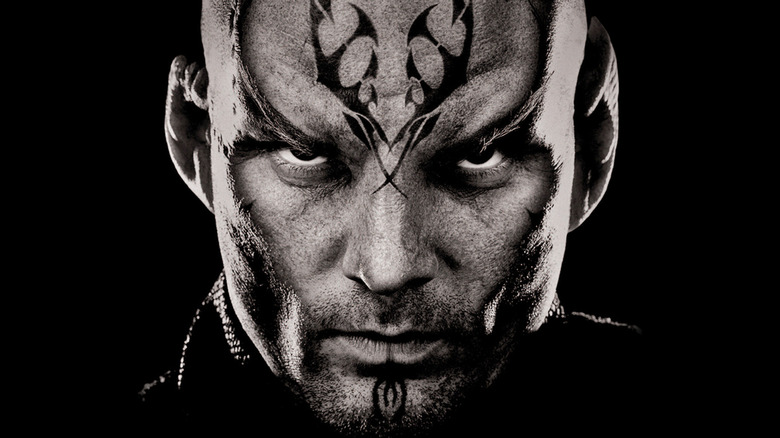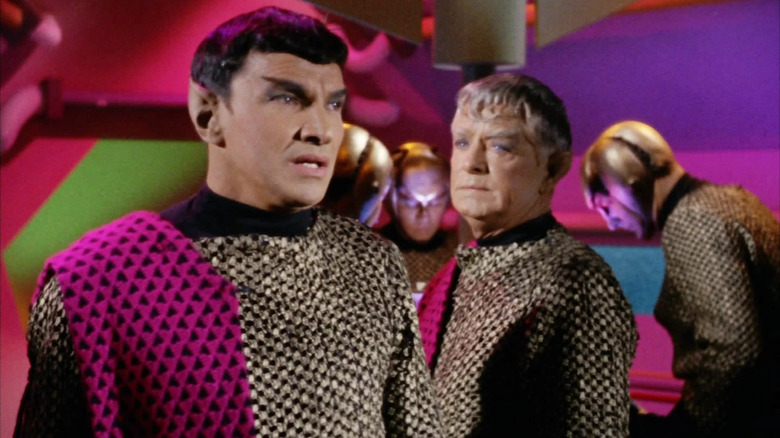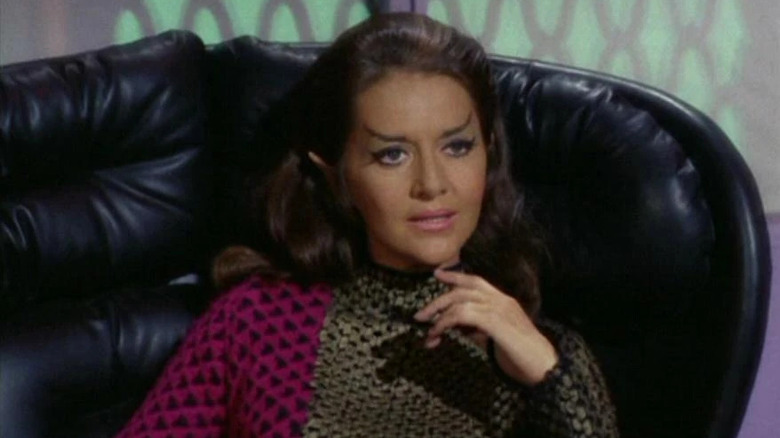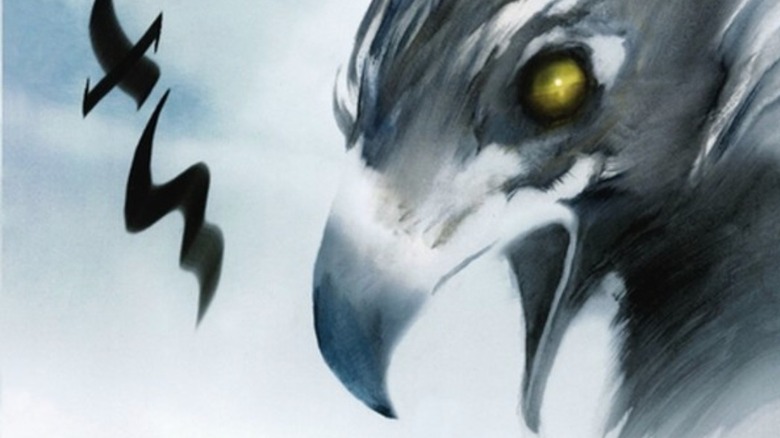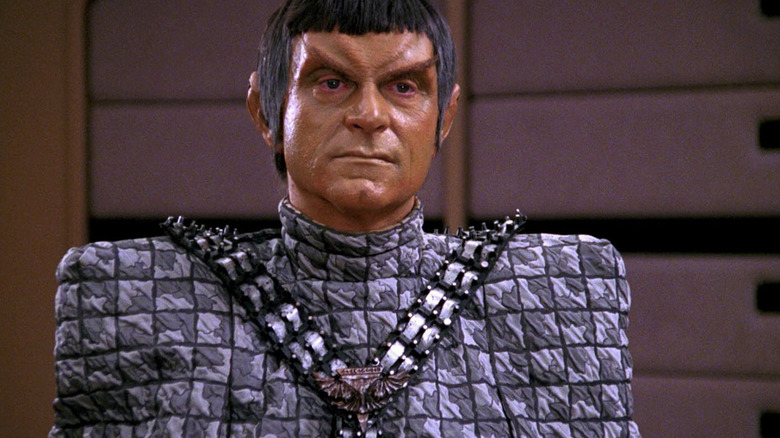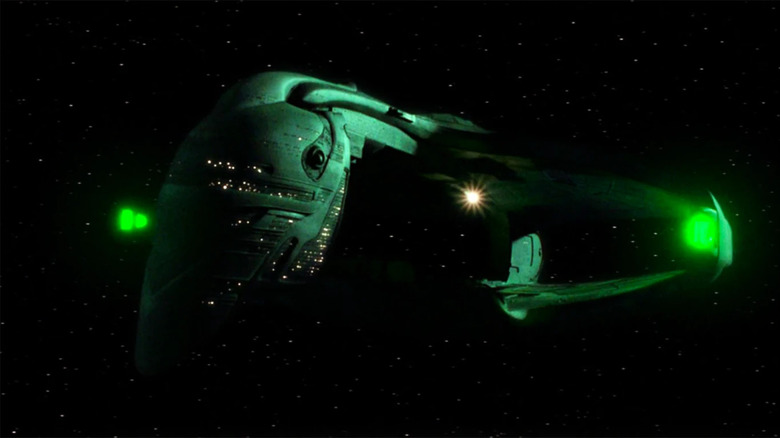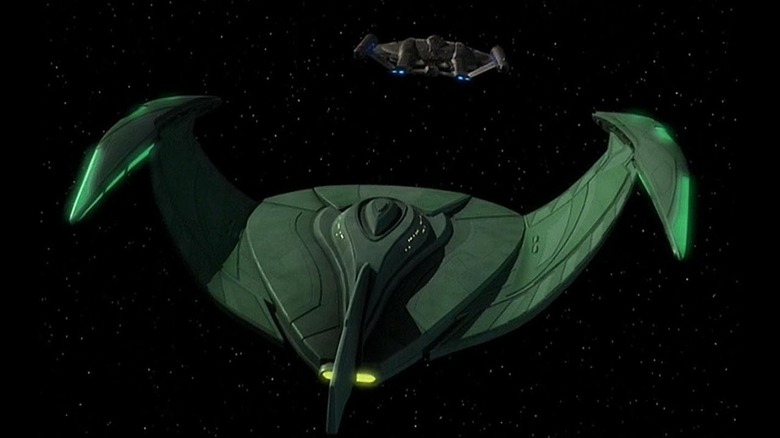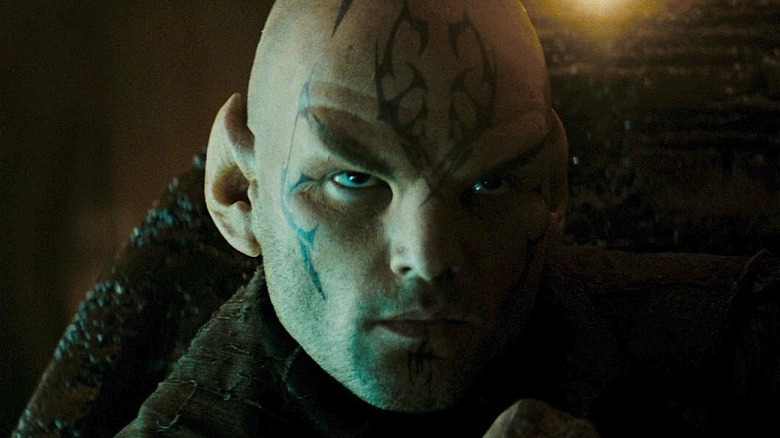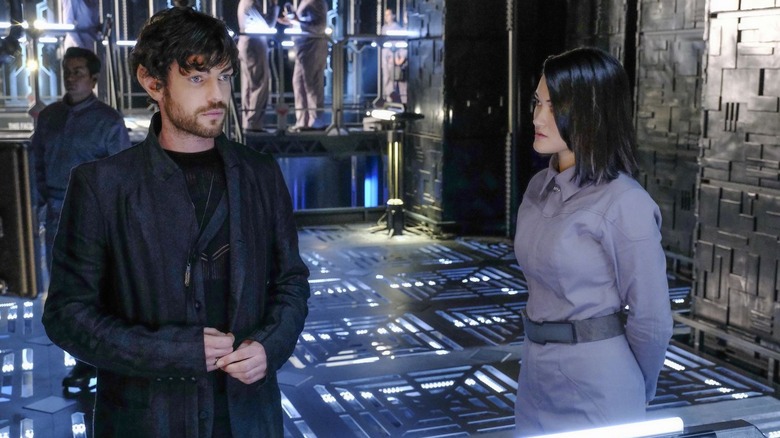The History Of The Romulans, And Their Place In The Star Trek Universe
"Star Trek" is home to countless alien races, but few have as enduring a presence in the franchise as the Romulans. They're the most persistent adversaries of the Federation, so much so that blue-tinted Romulan Ale remains under trade embargo. This hostility makes it all the more ironic that they resemble humanity's first alien allies, the Vulcans, sharing their pointed ears and arched eyebrows.
The in-universe origin of the Romulans is that they were Vulcans, millennia ago. In that distant past, the Vulcans were a warlike people, far from the cold logicians that fans know. That changed when (in Earth's 4th century), the philosopher Surak taught his people to embrace logic and master their emotions. Not all Vulcans accepted Surak's teachings; "Those Who March Beneath The Raptor's Wings" were eventually exiled from Vulcan. These dissident Vulcans settled on the twin planets Romulus and Remus, evolving into the Romulans and personifying a violent path not taken by their Vulcan cousins.
"Star Trek" is big on allegory — the interstellar powers represent the geopolitics of the 20th century. The Federation is the United States of America, a democracy of many member states. As the Federation's most pressing rival, the Klingon Empire is the Soviet Union. The Romulan Star Empire is China, a "sleeping dragon" superpower.
So, why have the Romulans endured as a crucial part of "Star Trek" history — and what does their role in that history look like?
Romulans in the Original Series
The Romulans were created by writer Paul Schneider, debuting in the season 1 episode "Balance of Terror." The episode features the Enterprise reacting to the destruction of outposts along the Romulan Neutral Zone; the culprit is a Romulan ship armed with a cloaking device. The Romulans flee back home while the Enterprise pursues its invisible quarry in a cat-and-mouse game.
This episode established the Romulan Star Empire had fought humanity in a devastating war a century ago. The war ended with a Neutral Zone established between the two parties' territories. Notably, no human had ever seen a Romulan in this time (or at least, no human who survived to tell about it). That means the Enterprise crew is stunned when they discover their adversaries are identical to Vulcans. The Romulans' exact backstory isn't spelled out, but Spock (Leonard Nimoy) speculates they are a Vulcan offshoot who retained his ancestors' warlike ways.
Schneider modeled the Romulans on the Romans; their twin homeworlds are named for the mythical founders of Rome and they employ ranks like "Centurion." Interviewed for "The Captains' Logs" by authors Edward Gross and Mark Altman, Schneider explained: "I came up with the concept of the Romulans which was an extension of the Roman civilization to the point of space travel, and it turned out quite well."
The Romulans' ship, dubbed a "Bird of Prey" due to the hawk painted on its underbelly, also created an association between the Romulans and birds. By "Star Trek: The Next Generation," their imperial insignia had evolved into a stylized raptor. Their ancestors' moniker, "Those Who March Beneath The Raptor's Wings," was probably extrapolated from this connection too by writer André Bormanis (the name first appears in "Star Trek: Enterprise" episode, "Awakening," written by Bormanis).
Further appearances
"Balance of Terror" is one of the most acclaimed episodes of "Star Trek: The Original Series." It was even semi-remade for the season 1 finale of "Strange New Worlds," titled "A Quality of Mercy." The unnamed Romulan Commander (played by Mark Lenard, who would go on to play Spock's father, Sarek) is an especially well-remembered villain, predating Khan Noonien Singh as the first worthy adversary of Captain Kirk (William Shatner) and the Enterprise. Even with his last words, he retains dignity and honor: "I regret that we meet in this way. You and I are of a kind. In a different reality, I could have called you friend."
Despite this dynamite debut, the Romulans made only two more appearances in "The Original Series." They are the antagonists of the season 2 episode "The Deadly Years," about the Enterprise crew succumbing to premature aging. However, only their ships are seen, not the Romulans themselves. They make a second and final onscreen appearance in season 3's "The Enterprise Incident" (written by the legendary D.C. Fontana). In this episode, Spock seduces a Romulan commander (Joanne Linville) while Kirk poses as a Romulan officer to steal her ship's cloaking device.
According to "The Art of Star Trek" by Judith and Garfield Reeves-Stevens, "Romulans were originally intended to be more of an ongoing threat to the crew of the Enterprise, but the make-up requirements proved too expensive. Klingons were cheaper." Note how, in "Balance of Terror" and "The Enterprise Incident," Romulan extras often wear ear-concealing helmets — an easy way to bypass make-up expenses.
The Romulans had only minor roles in the six theatrical "Star Trek" films featuring the original cast. They were rejected as villains of the third film, "The Search for Spock," again in favor of the Klingons (this is why the Klingons in that film have a cloaked ship called a Bird of Prey).
The Rihannsu
During the 1980s, the Romulans took center-stage in "Rihannsu," a five-novel series written primarily by Diane Duane (Peter Morwood co-authored the second, "The Romulan Way.") Published from 1984 to 2006, the novels invented a culture and language for the Romulans wholesale; they are technically not "Trek" canon but remain acclaimed for their world-building.
"Rihannsu" ("The Declared") is the Romulans' native name for themselves, akin to how German people call their nation "Deutschland," the Japanese call theirs "Nippon," etc. They are driven by "D'era," an expansionist impulse akin to Manifest Destiny, and "Mnhei'sahe" (ruling passion), a complex code of conduct that is foremost a rejection of the Vulcan system of logic.
"Mnhei'sahe" is weighed by one's personal strength and devotion to the Empire. Romulans seek power not for personal benefit per se, but because greater power serves the Empire. Selflessness is an alien concept to the Romulans; do things for the sake of your own Mnhei'sahe and others will benefit in the process. "Mnhei'sahe" spreads its claws even into simple Romulan social interactions, where the ideal outcome is for both parties to depart with their honor intact.
Much of Duane's other additions are inferences based on "Balance of Terror" and "The Enterprise Incident." Akin to Rome, the Romulans are an Oligarchic Republic; a Praetor is elected by the Senate itself, not the people at large. "The Enterprise Incident" showed a Romulan woman with a high military rank. So, "Rihannsu" gave the Romulan society a matriarchial tilt; a Romulan's family lineage is derived from their mother, not their father.
Much of "Rihannsu" is a holdover from the suggestion in "Star Trek: The Original Series" that Romulans were a warrior culture. For instance, their society has a semi-feudal system with a strong emphasis on family affiliation. Canon material would take a different path, showing Romulans as militant but not exactly honorable.
The Next Generation
In "Star Trek: The Next Generation," the Klingons were now good guys (mostly). They also became the go-to warrior race of "Star Trek"; Klingon society took on Viking and Samurai characteristics, where war, personal honor, and feudal affiliation were everything.
The Romulans became less and less the noble Roman-esque adversaries that Schneider had conceived of, with "TNG" instead highlighting their duplicity (with the cloaking devices) and isolationism. Thus, the stereotypical traits of Romulans became paranoia, deception, and xenophobia.
The Romulans were reintroduced in "TNG" season 1 finale, "The Neutral Zone," where it's said they had stayed out of galactic affairs for much of the 24th century. The episode (where several of their colonies are destroyed by the to-be-revealed Borg) awakens them. Creator Gene Roddenberry had initially not wanted to use the Romulans, but poor reception to the Ferengi meant the Federation needed a new adversary. Thus, the Romulans became the most frequent alien antagonist in the series; the Federation and Klingons were united as their enemies. Recurring Romulan villains included Tomalak (Andreas Katsulas) and Sela (Denise Crosby).
The most notable additions to the Romulans in "TNG" included V-shaped forehead ridges (dimorphic evolution from their Vulcan cousins), the D'deridex Class (enormous green warships descended from the Birds-of-Prey from "The Original Series"), and the Tal Shiar, Romulus' secret police.
Romulan highlights in "TNG" include "The Defector" (a Romulan military officer defects to the Federation) and "Reunification" (where Ambassador Spock has begun a push on Romulus for the two peoples to be one again).
The Next Generation (cont'd)
The Romulans weren't as prominent in "Deep Space Nine" as in "The Next Generation," but that series featured them finally uniting with the Federation. While the Federation and Klingons fight a losing war with the expansionist Dominion, the Romulans initially stay on the sidelines.
In the season 6 episode, "In The Pale Moonlight," Captain Sisko (Avery Brooks) and Garak (Andrew Robinson) falsify evidence of the Dominion's plans to invade Romulus and try to sway Senator Vreenak (Stephen McHattie). When their deception is revealed, Garak (with Sisko none the wiser until it's done) pulls a move the Romulans would be proud of: he assassinates Vreenak and frames the Dominion. Thus, the Romulans join the war as allies, and remain so until the series' end.
The Romulans finally got a silver screen spotlight in "Star Trek: Nemesis," the final "TNG" theatrical film. The Romulan Senate is assassinated by a bio-weapon and a new Praetor, Shinzon (Tom Hardy), seizes power. It turns out Shinzon is a failed clone of Picard, the product of an aborted spying operation. The biggest wrinkle "Nemesis" introduces to the Romulans is the Remans. Playing on the pre-established twin planets Romulus and Remus, the grey-skinned Remans are a slave race, toiling as forced laborers and shock troops.
The film skimps on the details of Reman history, so viewers can surmise they evolved on Remus and were subjugated by the Romulans. However, the novel trilogy "Vulcan's Soul" by Josepha Sherman and Susan Shwartz builds on the Remans displaying telepathy like the Vulcans (which the Romulans have always lacked). In this telling, the Remans were Vulcan exiles who refused to give up their telepathy and so were oppressed by the future Romulans; their appearance stems from the poor living conditions on Remus.
Looking to the past
"Star Trek: Enterprise" was a prequel set in the 22nd century, beginning before first contact between humans and Romulans. That event was depicted in the season 2 episode "Minefield," when the Enterprise stumbles into Romulan territory and is disabled by a cloaked minefield. True to canon, only the Romulans' ships are seen in the episode.
The Romulans finally took a larger role in season 4. The three-parter, "The Forge/Awakening/Kir'Shara" was about a Vulcan conspiracy to invade the Andorians. The ending revealed that Vulcan Administrator V'Las (Robert Foxworth) was in league with the Romulans and secretly working towards reunification. A subsequent three-parter, "Babel One/United/The Aenar," featured the Romulans as the explicit villains. A Romulan drone-ship, equipped with a holographic projector and controlled by Admiral Valore (Brian Thompson), attacked ships throughout the Alpha Quadrant to ferment dissent (the story begins with it destroying an Andorian ship while disguised as a Tellarite one, it later destroys a Rigellian freighter while disguised as Enterprise, etc.). However, the attacks only wind up bringing the targeted races together.
"Enterprise" established a firm timeframe for the Earth-Romulan War: 2156 to 2160. Moreover, the war was revealed as the event that brought the Federation together; Humans, Vulcans, Andorians, and Tellarites united in a military alliance against Romulan expansionism and never broke apart. The Romulans' increased presence in season 4 was building up to the war, but unfortunately, "Enterprise" was canceled before subsequent seasons could depict it. Thus, the Earth-Romulan War remains undepicted onscreen, confined to novels "Beneath The Raptor's Wings" and "To Brave The Storm" (both by Michael A. Martin).
The home world destroyed
Romulans were again the villains of a "Star Trek" film in director JJ Abrams' eponymous reboot. In the year 2387, Romulus and Remus are destroyed when their star goes supernova, shattering the Empire. Spock manages to contain the explosion with the substance Red Matter, opening a wormhole that sends him back in time to the 23rd century. Following him is the Romulan mining vessel the Narada, captained by vengeful Captain Nero (Eric Bana) — his name is another allusion to ancient Rome.
The Narada's presence creates an alternate timeline; Nero and his men destroy Vulcan with Red Matter before being defeated themselves. Nero and the Narada's crew stand out from other Romulans thanks to their shaved heads and tattoos; the admittedly non-canon comic "Star Trek: Countdown" suggests this is part of a mourning ritual. Normally the tattoos would fade, but Nero and his crew burnt them into their skin to ensure they'd never forget the loss of their home.
"Star Trek" returned to the "TNG" era with "Picard" and followed on from this point. It turns out that Starfleet offered to help evacuate Romulus, but after an attack on Mars, reneged on the plan; Picard himself resigned in disgust. The Romulans are far from extinct though. The Empire has collapsed into warring factions, one of which is the Romulan Free State. According to "Star Trek: Discovery," Vulcan/Romulan reunification will have become a reality by the 31st century. The groups remain culturally divided, but they again exist on the same planet, renamed from Vulcan to "Ni'var" (meaning two combined into one).
Romulan worldbuilding
Michael Chabon, showrunner of "Picard" season 1, also shared (via Medium) worldbuilding notes on the Romulans. These presumably influenced his onscreen depiction of them. Chabon writes that the Romulans are such secretive people that there is nothing more intimate to them than the truth; marriages have three participants because there must be third-party verification in everything.
The Romulan government is organized like an espionage network, with multiple competing cells, while Romulans all have four names: the common name (used for familiarity), imperial name (the state-recognized name), open name (for outsiders), and their true name (used only for close intimacy). Chabon suggests that a rumored reason for the Romulans' secrecy is the abundance of camouflaged predators on their adopted homeworld; their cloaked warbirds are modeled on a raptor whose plumage blends into the horizon.
Not all depictions of the Romulans totally align — compare Duane's Rihannsu to Chabon's Romulans. However, they all draw upon "The Original Series" and make inferences from there. "Star Trek" writers and fans aren't much different; they both take canon material and expand on it with some imagination.
"Star Trek" and its spin-offs are streaming on Paramount+.
